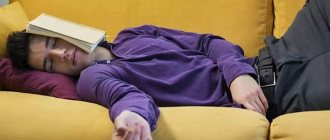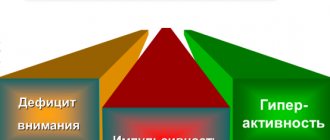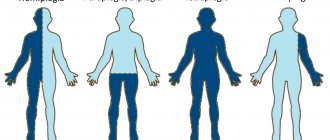Physical fatigue after minor exertion, deterioration of attention and everyday absent-mindedness, difficulties in remembering, headaches and constant apathy towards everything, lack of vital energy, sleep disturbances - such symptoms are common, but many people mistake them for fatigue (“You need to sleep on the weekend,” “It's time to go on vacation”) or even laziness.
Such an attitude towards one’s own health can lead to physical exhaustion, severe depression, loss of self-confidence and even the appearance of suicidal thoughts. After all, if nothing works out, where does high self-esteem come from?
Important
Astheno-depressive syndrome is a sign of exhaustion of the nervous system. The reasons for it can be very different, so you need to consult a specialist for diagnosis and treatment.
All these symptoms indicate a disease that requires competent and long-term treatment from a specialist.
What is astheno-depressive syndrome
Asthenic and astheno-depressive disorder are disorders that are characterized by excessive fatigue, fatigue after minor exertion, increased perception of stimuli (a person is irritated by bright lights, loud sounds), and anxiety. If, in addition to these symptoms, a person remains in a depressed, depressed mood for more than two weeks, then the disorder is called astheno-depressive.
Astheno-depressive syndrome can be an independent disease, can act as a sign of an organic disease (brain tumors, metabolic diseases, hormonal imbalance), or can be part of the structure of depression, bipolar affective disorder, sometimes even schizophrenia.
School maladjustment in pediatric practice
The beginning of schooling places new, more complex demands on the child’s personality and intellectual capabilities. This is due to the transition to a completely different set of mental, emotional and physical stress compared to the previous conditions of raising children in the family and preschool institutions.
Parents often come to consult a doctor whose children have a normal level of mental development and are quite capable of studying in a comprehensive school, but at the same time cannot successfully cope with the volume of educational loads or master school skills; in addition, they are often characterized by problems associated with inappropriate behavior. Often teachers in preschool institutions begin to pay attention to such difficulties in children when conducting various developmental activities, including in preparation for school.
In recent years, difficulties arising in the process of schooling have become the focus of attention not only of teachers and psychologists, but also of doctors. The causes of school maladjustment (SD) in children can be of a completely different nature. But at the same time, their external manifestations, which teachers and parents pay attention to, are similar. It is customary to consider the following main criteria and forms of manifestations of SD.
- Cognitive, or cognitive, component - poor academic performance in programs appropriate to the child’s age and abilities, with insufficient knowledge and development of learning skills, chronic academic failure.
- The personal, emotional and evaluative component of SD is constant violations of the emotional and personal attitude towards individual subjects and learning in general, teachers, as well as prospects related to studies.
- The behavioral component of SD is systematic violations of behavior during the learning process and at school.
In most children with SD, all three of the above components can be clearly seen. The predominance of one or another component among the manifestations of SD depends, on the one hand, on age and stages of personal development, and on the other, on the reasons underlying SD.
In their practical work, pediatricians, school doctors, pediatric neurologists and psychologists most often have to deal with conditions leading to the formation of SD, such as asthenic syndrome, cerebrasthenic syndrome, and minimal cerebral dysfunction. Less commonly, the cause of SD is various mental illnesses, if suspected, the child should be promptly referred for consultation with a psychiatrist.
If difficulties in learning are associated with low and unstable performance, high fatigue, insufficiently developed ability to control one’s activities, and a slow pace of assimilation of educational material, then after an appropriate examination, in many cases asthenic or cerebrasthenic syndrome is diagnosed. The development of asthenic syndrome is associated with somatic pathology. In cerebrasthenic syndrome, deviations in the processes of maturation and functioning of the central nervous system (CNS) are associated with its organic damage.
Asthenic syndrome
Symptoms of an asthenic nature are often one of the first nonspecific manifestations of a wide range of somatic disorders. Somatogenic asthenic conditions can be associated with unbalanced nutrition (protein-calorie deficiency, deficiency of vitamins, microelements), disorders of food absorption (malabsorption syndrome) in chronic diseases of the gastrointestinal tract, metabolic pathologies, with frequent colds and chronic infectious diseases (sinusitis, tonsillitis, etc.). Manifestations of asthenic syndrome are often observed in diseases of the respiratory system, bronchial asthma, diseases of the cardiovascular system, blood diseases, anemia, chronic diseases of the liver, pancreas, kidneys, endocrine pathology (thyroid diseases, diabetes mellitus).
Clinical manifestations of asthenic syndrome are increased fatigue, difficulty concentrating, and delayed perception. Children with asthenic syndrome stand out among their peers for their behavior: along with lethargy and exhaustion, many of them are overly shy, indecisive, and fearful. They are characterized by emotional lability, high vulnerability and touchiness. Children get upset over every trifle and start crying at the slightest failure. Hyperesthesia is often observed, expressed in intolerance to irritants such as loud sounds, bright light, and certain odors. Complaints of headaches may be due to other children making a lot of noise.
Asthenic symptoms in some cases are combined with anxiety, suspiciousness, and obsessive fears. Sleep disorders often occur. Sleep becomes superficial, restless, and is often accompanied by frightening dreams. Children have trouble falling asleep and have difficulty waking up, and there is no feeling of rest after sleep. Drowsiness may occur during the daytime.
Treatment is largely determined by timely diagnosis and treatment of primary somatic pathology, as well as the characteristics of the course of the underlying disease. Nootropic drugs are highly effective in treating manifestations of asthenic syndrome.
Cerebrasthenic syndrome
The discovery in a child during examination of mild residual manifestations of organic damage to the central nervous system usually serves as the basis for diagnosing cerebrasthenic syndrome. The causes of the development of cerebrasthenic syndrome include various forms of pathological course of pregnancy and childbirth associated with impaired oxygen supply to the brain of the fetus and newborn. Asphyxia in a full-term newborn almost always has an intrauterine origin; hypoxia and ischemia develop simultaneously; the result is hypoxic-ischemic encephalopathy. Other pathological conditions include intrauterine infections, taking medications by pregnant women, prematurity, and in newborns - intracranial hemorrhage, hemolytic disease, sepsis, and pneumonia.
Cerebrasthenic syndrome develops in most children who have suffered traumatic brain injury (TBI), neuroinfections (meningitis, encephalitis) or general infections with toxic brain damage. The uniqueness of the clinical course and outcomes of TBI in children is due to the fact that mechanical energy affects the brain, the growth and development of which is not yet complete. In the clinical course of TBI, three periods are distinguished: acute - the first 2-10 weeks, intermediate - 10 weeks-6 months, long-term - from 6 months to 2 or more years. Even mild TBIs do not go away without leaving a trace in childhood. Thus, approximately 1/3 of children who have suffered a concussion in the long term have complaints of headaches, increased fatigue, and difficulties in school learning (the so-called “post-concussion syndrome”). Moderate and severe TBIs lead to more serious consequences, but at the same time, in children, more often than in adults, a favorable outcome is possible even after severe TBI, due to the high compensatory capabilities and plasticity of the developing brain. To prevent persistent cognitive impairment in the long-term period of TBI, attention should be paid to the presence of manifestations of cerebrasthenic syndrome in the intermediate period of TBI, which are an indication for therapeutic courses with nootropics.
Cerebrasthenic syndrome develops in many children after various surgical operations. Its trigger is various types of hypoxia during surgery: anemic, circulatory, histotoxic. In the postoperative period, various extracerebral factors continue to operate: hypovolemia, surgical bleeding, dysfunction of the cardiovascular system and acid-base balance, hypoxemia.
A typical manifestation of cerebrasthenic syndrome is the so-called “irritable weakness.” On the one hand, children are characterized by general passivity, lethargy, slowness in thinking and movement; even with minor neuropsychic stress, exhaustion is observed, and the mood level is reduced. Fatigue is sometimes so severe that children are contraindicated from staying with their peers for a long time. On the other hand, there is increased irritability, readiness for affective outbursts, and insufficient criticality.
The occurrence of asthenic symptoms against the background of organic changes in the central nervous system gives the cerebrasthenic syndrome a number of features. Weakness of attention and thinking is accompanied by a fairly pronounced and long-term decrease in mental performance, especially with any intellectual load in school-age children. Memory loss is often noted.
It is believed that increased excitability, irritability, affective explosiveness, as well as hyperesthesia to sounds and bright light are more characteristic of post-traumatic cerebrospinal fluid. With post-infectious cerebrasthenia, mood swings are more often observed, accompanied by tearfulness, moodiness, and dissatisfaction. Children with consequences of intrauterine brain lesions may exhibit various dysembryogenetic stigmas. The structure of cerebrasthenic syndrome also includes more or less pronounced disorders of autonomic regulation.
Frequent manifestations of cerebrasthenia are headaches, worsening in the afternoon due to fatigue, and vestibular disorders (dizziness, a feeling of lightheadedness when driving, accompanied by nausea). In addition to driving, swings, heat and stuffiness, and weather changes with sharp fluctuations in atmospheric pressure are poorly tolerated.
Course of cerebrasthenic syndrome
As the central nervous system develops, various mechanisms of compensation for residual cerebral insufficiency are activated, therefore, the manifestations of cerebrasthenic syndrome are characterized by gradual regression. However, periods of decompensation may occur, especially during age-related crises. In addition to age-related physiological changes, the causes of decompensation can be fatigue associated with educational overload, psychotraumatic situations, various somatic diseases, and infections. Timely prescribed therapy with the inclusion of nootropic drugs contributes to the earliest and complete compensation of these disorders.
Minimal brain dysfunction (MCD) is the most common form of neuropsychiatric disorders in childhood. MMD are usually the consequences of early brain damage; their main characteristic is the age-related immaturity of individual higher mental functions and their disharmonious development. MMD is accompanied by a delay in the rate of development of functional brain systems that ensure the implementation of higher mental functions: speech - oral and written, attention, memory, perception, executive functions (programming, regulation and control) and a number of others. In terms of general intellectual development, children with MMD do not lag behind their peers, but at the same time experience significant difficulties in school learning and social adaptation.
The main clinical variants of MMD among school-age children are represented by attention deficit hyperactive disorder (ADHD), as well as specific difficulties in developing writing, reading and arithmetic skills - dysgraphia, dyslexia and dyscalculia. It is generally accepted that the pathogenesis of MMD is associated with the impact of various pathological factors on the developing brain during pregnancy and childbirth. The central nervous system is especially vulnerable when oxygen deficiency occurs, and biochemical and morphological changes caused by hypoxia can, to one degree or another, distort the normal course of complex processes of brain development. At the same time, studies in recent years have confirmed the significant role of hereditary mechanisms in the formation of MMD.
Attention deficit hyperactive disorder is manifested by motor hyperactivity unusual for normal age indicators, defects in concentration, distractibility, impulsive behavior, problems in relationships with others and learning difficulties. Children with ADHD are also distinguished by their awkwardness and clumsiness, which are associated with insufficient development of motor coordination. The prevalence of ADHD is quite high - 3-5% of school-age children. ADHD is 5–7 times more common among boys than among girls.
Hyperactivity is characterized by the fact that children are extremely active, constantly running, spinning, and trying to climb somewhere. Parents are oh, unable to sit still. Hyperactivity is also manifested by restlessness and extraneous movements during tasks that require perseverance (fidgeting in a chair, unable to keep arms and legs motionless). These children often experience a combination of excessive motor activity and destructive behavior. Thus, at school they constantly disturb teachers and provoke misbehavior among classmates.
Defects in concentration are the cause of poor performance in school lessons. According to teachers' descriptions, children with ADHD are able to maintain attention for no more than a few minutes. At the same time, indicators of concentration in children with ADHD are also subject to significant fluctuations. Parents often report that during activities and games that children are able to successfully complete, they can maintain attention for up to several hours. Such “selectivity” of attention is associated with interest, enthusiasm and pleasure from this activity. Hyperactive children perform worst on tasks that seem boring and difficult to them.
Impulsivity in such children is constantly observed both in a variety of everyday situations and when completing school assignments. During lessons, children have difficulty waiting their turn, interrupt others, answer questions inappropriately, without listening to them fully. Due to their impulsiveness, they are prone to traumatization, as they often commit dangerous actions, the consequences of which they do not think about. At the same time, impulsiveness provokes constantly emerging problems in relationships with others, including parents, brothers and sisters, and teachers. In a group, a child with ADHD is a source of constant anxiety: he makes noise without thinking, takes other people’s things, disturbs others, distracting them. All this leads to conflicts, as a result of which the child feels unwanted and rejected. Most children with ADHD are characterized by low self-esteem and weak psycho-emotional stability in the face of failures.
During school hours, children with ADHD find it difficult to cope with the assigned tasks, as they have difficulty organizing and completing work. Their reading and writing skills turn out to be much less developed than those of others. Written work is sloppy and prone to errors, which may be the result of inattention, failure to follow teacher instructions, or guessing without considering all possible options. At the same time, children are not inclined to listen to the advice and recommendations of adults. The difficulties in developing writing and reading skills in attention deficit hyperactivity disorder, along with attention disorders, are based on insufficient coordination of movements, visual perception and speech development.
In recent years, standardized diagnostic criteria for ADHD have been developed, representing a list of the most characteristic and clearly visible signs of this disorder. The diagnosis of ADHD is based on the criteria of the 10th revision of the International Classification of Diseases (WHO, 1994).
Attention-deficit hyperactive disorder: diagnostic criteria
I. Attention disorders
- Often unable to concentrate on details; due to negligence and frivolity, he makes mistakes in school assignments, work and other activities.
- Usually has difficulty maintaining attention when completing tasks or playing games.
- Often it seems that the child does not listen to those who address him.
- Often it is not possible to adhere to the proposed instructions and fully cope with lessons, homework or duties at the workplace (which has nothing to do with negative or protest behavior, or an inability to understand the task).
- Often has difficulty organizing independent completion of tasks and other activities.
- Typically expresses dissatisfaction and resists involvement in tasks that require prolonged attention (eg, school assignments, homework).
- Often loses things needed at school and at home (for example, toys, school supplies, pencils, books, work tools).
- Easily distracted by extraneous matters, objects, etc.
- Often shows forgetfulness in everyday situations.
II. Hyperactivity
- Restless movements of the hands and feet are often observed; sitting on a chair, spinning, spinning.
- Frequently gets up from his seat in the classroom during lessons or in other situations.
- Often exhibits aimless motor activity: runs, spins, tries to climb somewhere, and in situations where this is unacceptable.
- Usually cannot play quietly or quietly or do leisure activities.
- He is often in constant motion and behaves “as if he had a motor attached to him.”
Impulsiveness - Often talkative.
- Often answers questions without thinking, without listening to them completely.
- Usually has difficulty waiting his turn in various situations.
- Often interferes with others, pesters others (for example, interferes in conversations or games).
To make a diagnosis, six or more of the nine listed symptoms of attention disorders and/or six or more of the nine listed symptoms of hyperactivity and impulsivity must be present. The child's symptoms must persist for at least 6 months. In cases where the observed clinical picture fully corresponds to all of the listed diagnostic criteria simultaneously, a diagnosis of a combined form of ADHD is made. If there are six or more symptoms of attention impairment and less than six symptoms of hyperactivity, the diagnostic formulation “ADHD with predominant attention impairment” is used. If there is full compliance of symptoms with the criteria for hyperactivity and partial compliance with the criteria for attention impairment, then the diagnosis is designated as “ADD with a predominance of hyperactivity and impulsivity.”
In clinical practice, we most often encounter children's hyperactivity and attention disorders caused by ADHD. However, in addition to ADHD, these disorders can serve as external signs of a number of other conditions.
Differential diagnosis of hyperactivity and attention deficit in children
- Individual characteristics of temperament: characteristics of behavior and cognitive functions of active, active children do not go beyond the boundaries of the age norm.
- Anxiety disorders: the child’s behavioral characteristics are associated with the action of psychotraumatic factors.
- Asthenic syndrome in somatic diseases.
- Cerebrasthenic syndrome: residual effects of traumatic brain injury, neuroinfection, intoxication.
- Endocrine diseases (thyroid pathology, diabetes mellitus).
- Sensorineural hearing loss.
- Epilepsy (absence forms; symptomatic, locally caused forms; side effects of antiepileptic therapy).
- Mental disorders: behavioral disorders; affective disorders (moods); mental retardation; autism; schizophrenia.
- Hereditary syndromes: Tourette, Williams, Smith-Magenis, Beckwith-Wiedemann, fragmental X chromosome and some others.
It is necessary to carefully distinguish between ADHD and a wide range of conditions that are similar to it only in their external manifestations, but differ significantly from ADHD both in the causes of occurrence and methods of correction. It is all the more important to take this into account because in recent years there has been a tendency towards an unreasonably frequent diagnosis of ADHD and the misconception that diagnosing ADHD does not present significant difficulties has become widespread.
By adolescence, hyperactivity in children with ADHD significantly decreases or disappears, but attention disorders continue to varying degrees until adulthood. A number of adolescents are experiencing increasing behavioral disturbances, aggressiveness, difficulties in relationships in the family and school, and academic performance is deteriorating. Irresponsible behavior, violation of family and social rules, significant difficulties in choosing and mastering a profession are often observed, and there is often a craving for alcohol and drug use. In this regard, the efforts of parents and specialists should be aimed at timely identification and correction of ADHD. Nootropic drugs are highly effective in the treatment of ADHD. It is advisable to conduct nootropic courses several times a year during periods of the most intense training loads.
At preschool age, the child masters oral speech. Upon entering school, he begins to master visual (written) images of letters. The perception and recognition of graphic images necessary for written language (reading and writing) occur in the visual area of the cerebral cortex (occipital lobe). This means that the visual analyzer is included in the work of the speech system of the brain, and its functions must be coordinated with the activities of the speech-auditory and speech-motor analyzers. The child needs to learn to translate a heard and spoken word into a visual image (writing) and vice versa, be able to translate a visual image into an articulatory and auditory one (reading).
Reading and writing are among the newest higher mental functions in phylo-ontogenesis, which are mastered in the process of special training. In their implementation, the most late-forming parts of the cerebral cortex, mainly the parietotemporal-occipital region of the left hemisphere, are of primary importance. In addition, the implementation of these functions becomes possible with close interaction between the visual, auditory and motor analyzers, as well as with a sufficient level of development of complex voluntary actions (eye movements along lines of text, coordinated movements of the hand and eyes when writing).
Dyslexia is a partial specific disorder of the reading process and one of the forms of underdevelopment of written speech, manifested in repeated persistent errors. Children with dyslexia experience significant difficulties in mastering the skill of reading and, as a rule, writing, despite the normal level of intellectual development, the absence of impairments in the visual and auditory analyzers and pedagogical neglect. Dyslexia in children is the inability to achieve a level of development in reading, writing and spelling skills that is proportional to their mental abilities. In other words, dyslexia is often accompanied by dysgraphia and dysorthography. The incidence of dyslexia has not been definitively established. Based on studies of school-aged children, estimates of the prevalence of dyslexia range from 5–10 to 15–20%.
After 1–1.5 years of schooling, almost 50% of children with dyslexia do not have reading skills. Some of them do not know the letters, and the rest, having learned part of the alphabet, read only short, familiar words, the images of which they have memorized globally, like a picture. 25% of children master slow syllabic reading, making a large number of errors, the rest read letter by letter. As a result, children with dyslexia are unable to understand the meaning of what they read.
Dysgraphia is a violation of the development of writing processes and one of the forms of underdevelopment of written speech, manifested in repeated errors of a persistent nature. There are optical, phonemic and grammatical (dysorthography) types of errors in writing. In case of optical errors, graphically similar letters are not distinguished: p-n, p-i, p-t, u-i, sh-i, m-sh, m-l, l-i, b-d, etc. With phonemic ( errors in the perception of speech sounds) - phonemes that have acoustic-articulatory similarities are not distinguished, most often voiced and voiceless: d-t, z-s, b-p, zh-sh, g-k, v-f, etc.
Difficulties in mastering reading and writing skills can have a negative impact on the development of a child's personality. Constant failures in school can cause and reinforce such traits as uncertainty, anxiety, isolation, and low self-esteem. In some cases, especially when there is an incorrect attitude towards the child’s difficulties on the part of adults, both parents and school teachers, accusing him of reluctance to learn, slowness, laziness and disobedience, children with dyslexia and dysgraphia develop neurotic, depressive states or oppositional and aggressive behavior. Timely use of nootropics in the treatment of dyslexia and dysgraphia in children contributes to the most complete correction of these conditions. It is necessary to take into account that the manifestations of dyslexia and dysgraphia are usually characterized by persistence and cannot be completely overcome in a short time.
Providing assistance to children with SD should be timely, comprehensive and combine various approaches, including methods of psychological and pedagogical correction, psychotherapy, and drug treatment. All children with SD should be examined by a psychologist. In order for assistance to a child to be effective, coordinated efforts of various specialists are necessary - doctors, psychologists, speech therapists, teachers. It is important that the joint efforts of specialists are aimed at early detection and correction of cognitive, emotional and behavioral disorders in children. Planning and implementation of corrective measures, including drug therapy, should be carried out according to individual plans for each child.
Nootropic drugs are a relatively new group of drugs that entered widespread pediatric practice in the 1980s. According to WHO experts, nootropic drugs are drugs that have a direct activating effect on learning, improve memory and mental activity, and also increase the brain’s resistance to adverse effects. Based on their chemical structure, nootropics represent a heterogeneous group of drugs. The main nootropics include the following classes of drugs: 1 - pyrrolidone derivatives (piracetam), 2 - γ-aminobutyric acid (GABA) derivatives (phenibut, pantogam), 3 - neuropeptides and their analogues (Cerebrolysin, Semax), 4 - pyridoxine derivatives ( encephabol), 5 - cerebrovascular drugs (nicergoline, vinpocetine), 6 - multicomponent drugs (instenon, actovegin) and a number of others. The high effectiveness of nootropic drugs in combination with good tolerability has been confirmed in many studies that assessed their effect in the treatment of various conditions accompanied by difficulties in development, learning and behavior in children.
Most nootropic drugs are prescribed in the first half of the day due to their psychostimulating effect. It is advisable to use nootropic drugs in the form of monotherapy, while paying attention to the individual selection of optimal dosages and duration of treatment. In the first days of use, a gradual increase in dose is recommended. The duration of nootropic treatment courses ranges from 1 to 2–3 months. If during the school year there is a need for several courses of treatment, then intervals of 2–4 weeks are left between them, which are best planned during the holidays. If the first course of treatment turns out to be insufficiently effective, then the issue of increasing the duration of treatment, prescribing a second course of nootropics after a break, or combining pharmacotherapy with methods of psychological and pedagogical correction should be decided individually.
It is important to note that side effects during treatment with nootropics in children are rare and are not persistent or significantly pronounced. They often occur when parents do not accurately follow nootropic regimens with a gradual increase in dose, taking drugs in the morning and afternoon. Possible side effects of nootropics include: a feeling of heaviness in the head, the appearance of excitability and irritability, difficulty falling asleep and restless sleep, rarely - nausea, discomfort in the stomach. If such complaints appear, clarifications should be made to the nootropic prescription regimen, and in some cases, the dose should be slightly reduced. Certain caution is required in prescribing nootropic drugs to patients with manifestations of intracranial hypertension. In such cases, at the first stage of treatment, dehydration therapy is prescribed or nootropics are used in combination with it.
In conclusion, it is necessary to emphasize once again that identifying the causes of SD and correcting its manifestations must be timely. Patients with SD are recommended to undergo a comprehensive examination with the participation of a pediatrician, neurologist, psychologist, and, if indicated, a psychiatrist. All children with SD require dynamic monitoring not only by a doctor, but also by a psychologist.
Our experience in the use of nootropic drugs indicates the positive effect of encephabol and instenon in the treatment of these conditions in children.
Encephabol (pyritinol) is a nootropic drug whose chemical structure is a double molecule of pyridoxine (vitamin B6).
Features of prescribing encephabol
- Release forms: tablets of 100 mg and suspension containing 20 mg of encephabol in 1 ml.
- Mechanisms of action: improves the transmission of impulses and their conduction to various parts of the brain, normalizes the energy metabolism of neurons, activates glucose metabolism in brain tissue, improves microcirculation in the brain.
- Minimum contraindications, approved for use from an early age.
- Recommended doses for children: up to 10–12 mg/kg body weight (daily dose up to 300–400 mg), in 2–3 doses, after meals, the last dose no later than 17:00.
- To avoid side effects at the beginning of the course, it is recommended to slowly increase the dose of encephabol over 7–10 days.
- Course duration is up to 6–12 weeks.
Encephabol is highly effective in the treatment of asthenic and cerebrasthenic syndromes, dyslexia and dysgraphia, ADHD.
If there are appropriate indications, long-term use is advisable, allowing to achieve a significant increase in performance, improvement in the state of higher mental functions and school learning skills.
| Instenon dosage regimens for children of different age groups |
Instenon is a multicomponent nootropic drug; in pediatric practice, a tablet form is used containing 1 tablet 50 mg of etamivan, 20 mg of hexobendine, 60 mg of etophylline. Instenon is especially effective in the treatment of ADHD and can be recommended for the treatment of asthenic and cerebrasthenic syndromes. Depending on age, the daily dose is 1.5–2.5 tablets, prescribed in 2 doses (morning and afternoon) after meals. It is recommended to begin therapy with a gradual increase in dose over 7–10 days. The duration of treatment is from 4 to 6–8 weeks. Instenon dosage regimens for children of different age groups are given in the table.
N. N. Zavadenko , Doctor of Medical Sciences, Professor of Russian State Medical University, Moscow
How to recognize the disease
Fatigue and tiredness are a normal reaction of the body to stress. We should talk about a disease when this condition does not go away even after a long rest or change of activity and persists for 2–3 weeks.
Symptoms that require you to consult a doctor:
- Nothing makes me happy. Things that used to bring you pleasure (hobbies, watching your favorite movies or hanging out with friends) begin to irritate, tire you, or bring tears to your eyes.
- Sleep disorders: you can’t fall asleep for a long time at night or have restless sleep, and during the day this makes you drowsy.
- Rest does not eliminate fatigue.
- Feeling exhausted after a load that was previously possible. Moreover, reducing the amount of work done does not improve the condition.
- Painful sensitivity to light or loud noise.
- A reduced mood level persists no matter what events happen in your life - good or bad.
- Mental abilities deteriorate, memory decreases. It becomes more difficult to concentrate on everyday activities, and absent-mindedness appears.
The most important thing is that the above symptoms persist for at least 2 weeks.
Important
Fatigue and depression may be accompanied by short-term vegetative crises (panic attacks). Without treatment, the disease “locks” a person at home, and panic does not allow him to even go outside.
Predisposed individuals are at risk of developing astheno-depressive syndrome with panic attacks. Short-term episodes of severe fear, panic with palpitations, cold sweat, and a feeling of shortness of breath can lead to a decrease in social contacts, loss of work, and even self-isolation of the patient.
Diagnostic principles
Before starting treatment, it is important to differentiate mental disorders from somatic ones. Identifying the root cause of asthenia after coronavirus is the basis for planning therapy. In addition, the possibility of secondary bacterial infection, relapse or reinfection should be excluded. To do this, it is recommended to undergo a number of clinical tests and laboratory tests:
- clinical and biochemical blood test;
- urine examination for the presence of protein, leukocytes and red blood cells (may indicate the development of kidney pathology);
- Covid test (by PCR and/or ELISA, although many doctors now talk about the likelihood of false-positive PCR results due to the “reaction” of the test systems used to viral particles circulating in the blood);
- ECG, according to indications - Echo-CG;
- X-ray and/or tomography of the chest;
- Ultrasound of internal organs (kidneys, liver, pancreas);
- coagulogram, D-dimer test to determine the risk of thrombotic complications.
If weakness and fatigue persist after coronavirus, regular measurement of saturation (oxygen saturation level in the blood) is recommended. To avoid false results, it is not recommended to use fitness bracelets, etc., of dubious quality. Only certified medical devices with attached detailed instructions are suitable.
Indications for emergency medical consultation
Weakness after Covid is quite normal, but the time frame for restoring well-being and performance varies from person to person and ranges from 2-3 weeks to 1-2 months. However, in some cases, medical attention may be required. Attention should be paid to the following symptoms:
- decrease in saturation to 95% or less;
- shortness of breath and pain in the chest, which intensifies with coughing, exertion, or taking a deep breath;
- cough;
- increased body temperature;
- a sharp deterioration in health.
Diagnosis of astheno-depressive disorders
The following methods help to find out the causes of asthenic-depressive disorder:
- Clinical and anamnestic examination is a conversation with an experienced and qualified psychotherapist who identifies symptoms and assesses what may cause the disease.
- Pathopsychological examination - performed by a medical psychologist. The specialist records deviations from the norm, which are revealed in tests of thinking, attention, and memory.
- Instrumental and laboratory research methods are indicated for differential diagnosis with organic disorders (EEG) and endogenous diseases, including schizophrenia (Neurotest, Neurophysiological test system).
- Consultations with related specialists (neurologist, sexologist, psychiatrist) - if necessary.
Neurocirculatory asthenia
Neurocirculatory asthenia has several other names, one of them is da Costa's syndrome.
The symptoms of neurocirculatory asthenia and signs of cardiovascular diseases are at first glance very similar. After physical exertion, a person begins to feel tired, he develops shortness of breath, rapid heartbeat, increased sweating, and pain in the chest area. But further examination of the patient usually shows that there are no disturbances in the functioning of the heart or blood vessels. The fact is that neurocirculatory asthenia is, first of all, an anxiety disorder, and it is treated accordingly.
Asthenia scale
The asthenic state scale was developed by L.D. Maykova, adapted by T.G. Chertovaya on the basis of clinical and psychological observations and the well-known MMPI questionnaire (Minnesota Multidimensional Personality Inventory).
The scale consists of 30 items of statements reflecting the characteristics of asthenic syndrome. The study is carried out individually in a separate, well-lit room, isolated from extraneous sounds.
Instructions for the test: Read each sentence carefully and evaluate it in relation to your current state.
Points for each answer are awarded according to the following scheme:
- No, not true – 1;
- Perhaps so – 2;
- True – 3;
- Absolutely right - 4.
Test material:
- I work under a lot of pressure;
- I find it difficult to concentrate on anything;
- My sex life does not satisfy me;
- The waiting makes me nervous;
- I am experiencing muscle weakness;
- I don't feel like going to the cinema or theater;
- I'm forgetful;
- I feel tired;
- My eyes get tired when reading for a long time;
- My hands are shaking;
- I have poor appetite;
- It is difficult for me to be at a party or in a noisy company;
- I don't understand what I read so well anymore;
- My hands and feet are cold;
- I am easily offended;
- I have a headache;
- I wake up in the morning tired, not rested;
- I get dizzy;
- I have muscle twitching;
- I have a buzzing in my ears;
- I am worried about sexual issues;
- I feel heaviness in my head;
- I experience general weakness;
- I experience pain in the crown of my head;
- Life for me is about tension;
- My head seems to be tied together with a hoop;
- I wake up easily from noise;
- People bore me;
- When I worry, I break out in sweat;
- Restless thoughts keep me awake.
The possible number of points ranges from: 30 -120
The test results can be interpreted as follows:
- From 30 to 50 points – “absence of asthenia”;
- From 51 to 75 points – “weak asthenia”;
- From 76 to 100 points – “moderate asthenia”;
- From 101 to 120 points – “severe asthenia”
Symptoms of asthenia
- Has fatigue become your usual state?
- Are the days divided only into those when you are simply tired and “deadly” tired?
- The sight of frolicking children and youth only evokes in you a silent question: “Where do they get so much energy?”
- Isn’t this the first day you’ve had this impression of life?
- Is your sleep disrupted, but calculating sheep and rams doesn’t help?
- Bags under the eyes, dull eyes, a forced smile, a total reluctance to do anything?
Doesn't remind you of anyone? Every second patient today consults a doctor with such complaints.
Treatment of astheno-neurotic syndrome
The need to visit a neurologist arises in situations where the child is too irritable and capricious, his school grades have deteriorated, or nervous breakdowns occur in which he raises his voice at adults. All such signs can indicate not character problems, but nervous disorders. Attempts to independently pacify a teenager by shouting (or punishing) only aggravate the problem.
The first step is to visit a pediatric neurologist. An experienced specialist will quickly find out what is really happening: is it asthenoneurosis or is the child simply manipulating his parents due to hormonal changes in his body. Most often, a child’s nervous system can be easily corrected with corrective and developmental exercises, after which everything is restored, returning to normal. Good treatment results are provided by:
- consultations with a psychologist, changing the style of everyday life;
- sand therapy;
- sensory integration.
When astheno-neurotic syndrome is provoked by organic damage to the central nervous system and brain, correction must be supplemented with rehabilitation measures.
In such a situation, doctors prescribe the following procedures:
- TANK;
- Audiotherapy according to the A. Tomatis method;
- TCM;
- Biofeedback trainings.
Symptoms of asthenoneurosis do not seriously threaten children's health, but prolonged asthenia significantly worsens the quality of life and delays intellectual and physical development. Treating the problem is a complex task; it requires the involvement of a professional team, a combination of various healing methods.
Treatment of organic emotionally labile personality disorder
Treatment must be comprehensive and strictly individual. With the correct diagnosis and adequate treatment, the symptoms of asthenic disorder may weaken or go away completely.
Organic emotionally labile asthenic disorder is treated with medicinal and non-medicinal methods. The following groups of pharmaceuticals are classified as medications:
- Vaso-vegetotropic - normalize the functioning of the autonomic nervous system
- nootropics - improve metabolic processes in brain tissue
- sedatives - have a calming effect by balancing the processes of excitation and inhibition of the nervous system
- neuroleptics - relieve anxiety
- antidepressants - relieve anxiety, normalize mood
Non-drug methods include:
- Individual psychotherapy - a psychiatrist-psychotherapist teaches a person to control behavior and relax. Helps you set priorities (achieve success at work, live in love and harmony with loved ones) and stick to them.
- Biofeedback therapy is a modern method of treating mental disorders. The specialist uses sensors and a computer to measure physiological indicators - breathing rate, heart rate, blood pressure level. As soon as a person managed to bring these indicators back to normal (following the specialist’s instructions), the computer reports success. The patient remembers relaxation skills and can then use them in emotionally stressful situations to gain self-control.
Diagnosis F06.6 Organic emotionally labile asthenic disorder often goes untreated - those around him and the person himself believe that he has a “severe character.” But it's not right. You can get rid of the symptoms of the disorder with the help of modern medications and non-drug methods and return to a full life.
Symptoms of organic asthenic disorder
People with the disorder are characterized by tearfulness, emotional irascibility, frequent and severe mood swings, and a storm of emotions, often over a minor issue. All reactions are spontaneous (occur without a serious reason or reason) and uncontrollable.
A person reacts painfully even to minor events; emotions, as a rule, are negative (anger, irritation, resentment).
He perceives troubles as “the end of the world”, constantly having outbursts of anger and irritability towards loved ones and surrounding people.
Diagnosis of organic emotionally labile disorder - examination by a psychiatrist and neurologist. Additionally, the attending physician may prescribe a pathopsychological examination, blood tests and instrumental methods (EEG, CT, MRI).
A person complains of regular and severe headaches, dizziness, decreased or blurred vision, increased blood pressure, and tinnitus. These complaints indicate a brain disease that has led to an organic emotionally labile disorder. They interfere with a person’s life and work, and because of them he goes to the doctor.
Hypersensitivity is characteristic - pain sensitivity in response to a slight touch on the skin, excessive auditory or light sensitivity, when ordinary sounds are perceived as very loud (up to the development of pain), and sunlight causes severe lacrimation and pain in the eyes.
Important
General weakness, rapid fatigue, decreased performance, a feeling of powerlessness - all these are integral companions of organic asthenic disorder.
Organic emotionally labile asthenic disorder in children occurs due to severe pregnancy of the mother (toxicosis, threatened miscarriage, eclampsia), complications during childbirth or severe diseases of early childhood.
An experienced psychiatrist can make a diagnosis during the first examination. The main manifestations of asthenic disorder include excessive moodiness, frequent tearfulness, disobedience, irritability, and inability to concentrate for a long time. Such children may develop sudden lethargy and lack of initiative. It is necessary to differentiate an emotionally labile disorder from character traits and age-related changes.
The prognosis for adults and children is favorable if the recommendations of the attending physician are followed.








